

Peru - History & Culture. Peru is best known as the heart of the Inca empire, but it was home to many diverse indigenous cultures long before the Incas arrived.

Although there is evidence of human habitation in Peru as long ago as the eighth millennium BC , there is little evidence of organized village life until about 2500 BC. It was at about this time that climatic changes in the coastal regions prompted Peru's early inhabitants to move toward the more fertile interior river valleys. For the next 1500 years, Peruvian civilization developed into a number of organized cultures, including the Chavìn and the Sechìn. The Chavìn are best known for their stylized religious iconography, which included striking figurative depictions of various animals (the jaguar in particular) and which exercised considerable influence over the entire coastal region. The Sechìn are remembered more for their military hegemony than for their cultural achievement. Peru: History. History of Peru - Lonely Planet Travel Information.
For many travelers, the first word that comes to mind when thinking of Peruvian history is ‘Inca.’

Indeed the Inca civilization, the best-known and most-studied of South America’s pre-Columbian cultures, is the one you’re most likely to encounter on the road. Yet the mighty Incas are merely the tip of the archaeological iceberg. Peru had a bounty of pre-Columbian cultures, some preceding the Incas by millennia. Peru is unequaled in South America for its archaeological wealth, and many archaeologists find Peru’s ancient sites and cultures as endlessly fascinating as those of Mexico, Egypt or the Mediterranean. Learning about and visiting these centuries-old ruins is the highlight of many travelers’ journeys as well, and even those travelers with limited interest in archaeology will find seeing some of the main sites rewarding. What we know of Peru’s pre-Columbian civilizations has been gleaned almost entirely from archaeological excavation. Preceramic period ^ Back to top Initial period. Shamanism. The earliest known depiction of a Siberian shaman, produced by the Dutch explorer Nicolaes Witsen, who authored an account of his travels among Samoyedic- and Tungusic-speaking peoples in 1692.
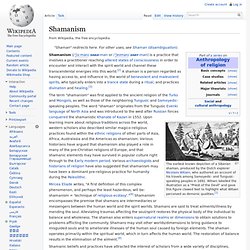
Witsen labelled the illustration as a "Priest of the Devil" and gave this figure clawed feet to highlight what Witsen perceived as demonic qualities.[1] Shamanism (/ˈʃɑːmən/ SHAH-mən or /ˈʃeɪmən/ SHAY-mən) is a practice that involves a practitioner reaching altered states of consciousness in order to encounter and interact with the spirit world and channel these transcendental energies into this world.[2] A shaman is a person regarded as having access to, and influence in, the world of benevolent and malevolent spirits, who typically enters into a trance state during a ritual, and practices divination and healing.[3]
Santo Daime. Ceremonies — "trabalhos" (Brazilian Portuguese for "works") — are typically several hours long and are undertaken sitting in silent "concentration", or sung collectively, dancing according to simple steps in geometrical formation.
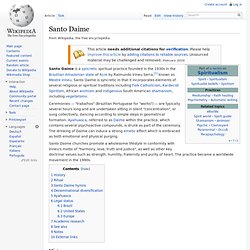
Ayahuasca, referred to as Daime within the practice, which contains several psychoactive compounds, is drunk as part of the ceremony. The drinking of Daime can induce a strong emetic effect which is embraced as both emotional and physical purging. Santo Daime churches promote a wholesome lifestyle in conformity with Irineu's motto of "harmony, love, truth and justice", as well as other key doctrinal values such as strength, humility, fraternity and purity of heart. Tapirapé people. Wai-wai people. The Wai-wai (also written Waiwai or Wai Wai) are a Carib-speaking ethnic group of Guyana and northern Brazil.
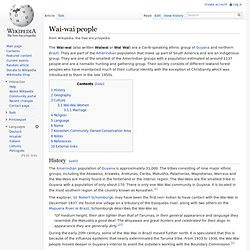
Mapuche. Historically the Spanish colonizers of South America referred to the Mapuche people as Araucanians (araucanos).
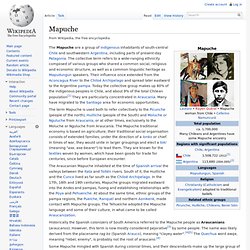
However, this term is now mostly considered pejorative[3] by some people. The name was likely derived from the placename rag ko (Spanish Arauco), meaning "clayey water".[4][5] The Quechua word awqa, meaning "rebel, enemy", is probably not the root of araucano.[4] History[edit] Pre–Columbian period[edit] Machi (shaman) Mapuche machis in 1903 A machi is a traditional healer and religious leader in the Mapuche culture of Chile and Argentina.

Machis play significant roles in Mapuche religion. Women are more commonly machis than men. Illustration of a machi healing a patient, from Atlas of Physical and Political History of Chile (Atlas de la historia física y política de Chile), by Claudio Gay As a religious authority, a machi leads healing ceremonies, called Machitun. The term is sometimes interchangeable with the word kalku, however, kalku has a usually evil connotation whereas machi is usually considered good; this, however, is not always true since in common use the terms may be interchanged. Cuzco Peru: Clear Evidence Of The Great Builders Before The Inca. Unexplained things are out there. Called “the cradle of civilization of the Western world,” the ancient city of Caral in Peru is known for its pyramids, which represent one of the world’s greatest discoveries.
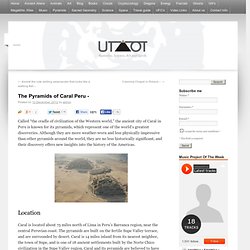
Although they are more weather-worn and less physically impressive than other pyramids around the world, they are no less historically significant, and their discovery offers new insights into the history of the Americas. Location Caral is located about 75 miles north of Lima in Peru’s Barranca region, near the central Peruvian coast. LOLO MIRO, Peruvian Painter and Mystic, Cuzco Peru.